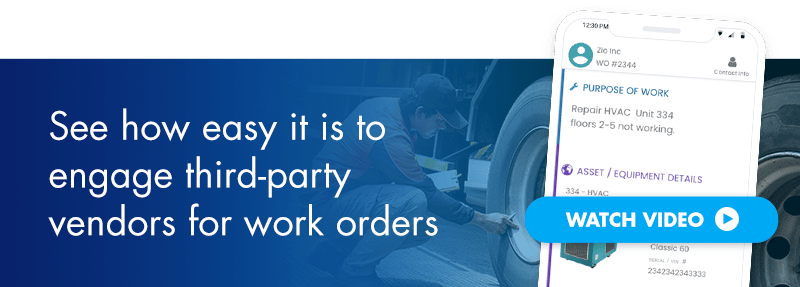How much time do you waste on back-and-forth phone calls and emails with outside vendors? When your asset is sitting idle as you try to figure out who is going to repair it and when, it’s become a liability.
You can get more done faster with an enterprise asset management (EAM) platform with work order software that streamlines managing third parties.
Although it’s difficult to measure exactly how much it costs your company, some sources estimate industrial manufacturers lose about $50 billion annually because of asset downtime. Organizations can’t afford to wait for outside resources to start on a work order.
How work order software streamlines vendor management
Although it’s more convenient to assign maintenance and repair work orders to your internal teams, it’s not always possible due to staff availability, level of expertise, and even cost. Sometimes hiring an external vendor just makes more sense.
When you use work order software that integrates your third-party vendors, you can close the communication gap and keep all your data in one place.
Best of all, your vendors can use their mobile devices to accept jobs, provide updates, and close out work order. And since they’ll be using a temporary URL, you don’t have to give them direct access to your system.
Manage machine failures
It’s hard to be strategic and forward-thinking when you’re constantly reacting to what just happened. You can change all of this by regularly measuring key performance metrics to inform future decisions.
Start by streamlining your data collection. Having all of your work orders in one place—including external work orders—means you also have all of the maintenance analytics in one place.
With work order software that integrates all your work orders and allows you to manage your third-party vendors, you’re able to collect vendor data in real time. This includes before and after photos that can be instantly uploaded and saved, providing visual data for failure analysis.
You can also drill down on asset-management patterns, such as above-average failures connected to a specific technician or a certain operator.
In other words, streamlining work orders for better analytics means a healthier bottom line as well as the ability to make the move from reactive to proactive.
Manage time
When communication with external vendors becomes a separate process, you waste valuable time as well as create more opportunities for mistakes due to delays, juggling systems, rekeying information, and other time-consuming, error-prone tasks.
When you manage your internal and external work orders from one platform, there’s no need to wait for return phone calls and emails. Working with outside vendors becomes more like working with members of your own teams.
When the software contains built-in templates and the ability to create your own custom fields, it saves your team time on data entry while ensuring everyone gets the information they need.
Once the vendor accepts the work order assignment, the process is moved along until completion. You can even monitor progress in real time rather than hunting down your vendor’s technician teams to ask for status reports.
Digital contact forms enable vendors to quickly contact the right person on your team when there are questions or concerns.
Since everything is saved in one place, you won’t risk losing or misplacing important data and documents.
In a nutshell, an all-in-one digital work order tool that streamlines vendor communication and workflows frees up your time for revenue-generating activities instead of reactive, unnecessary ones.
Manage costs
Advanced work order software can also help you manage costs.
Robust data analytics
Work order software that stores the data from external work orders right alongside your internal work orders gives you an easy way to review maintenance costs from a higher-level perspective.
Get a closer look at work order costs over a period of time to pinpoint which assets are costing you the most and the origin of those costs. Is there a particular asset that breaks down more often than it should?
How much are you spending on external work orders versus internal ones? Are some vendors much more expensive than others? Are they more effective, saving you money in the long run?
The data you collect gives you deeper insights that will inform other decisions, such as inventory counts and preventive maintenance scheduling.
Keep track of invoices
Receiving invoices for external work orders through a work order software vendor portal is faster and more efficient for both parties. When your system is integrated with your larger enterprise platform, you’ll never lose an invoice again.
You also have cost information automatically tied to the specific asset that was serviced, helping you create a more accurate total cost of ownership metric. And that cost data is essential for planning the asset’s lifecycle and forecasting your budgets.
An easy solution
Even if you have EAM or CMMS software, your ability to manage work orders is usually limited to your internal teams. In the new era of asset management, you need a platform that allows you to manage your external work orders through the same processes you use for those you assign to your own teams.
That’s why ManagerPlus introduced the Vendor Portal, a powerful work order tool that allows you to assign and manage work orders with outside vendors while never leaving the ManagerPlus system.
The new Vendor Portal is simple to use for you and your third-party vendors, and there’s no limit to the number of vendors you can add.
The process is simple: Just choose your vendor and get an immediate notification when they accept the job.
You can check on work orders in real time and request photos as well as a digital sign-off when the job is done. All of your vendor’s data is kept in one place, including invoices.
And you can always contact us for a personalized demo that includes the new Vendor Portal.

